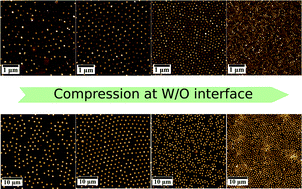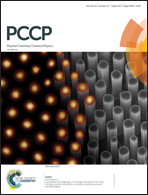Compression and deposition of microgel monolayers from fluid interfaces: particle size effects on interface microstructure and nanolithography†
Abstract
Controlling the microstructure of monolayers of microgels confined at a water/oil interface is the key to their successful application as nanolithography masks after deposition on a solid substrate. Previous work demonstrated that compression of the monolayer can be used to tune the microgel arrangement and to explore the full two-dimensional area–pressure phase diagram of the particles trapped at the interface. Here, we explore a new size range, using microgels with 210 nm and 1.45 μm bulk diameters, respectively. We start by investigating the properties of isolated particles in situ at the interface by freeze-fracture cryo-SEM, and after deposition using an atomic force microscope. We then study their collective behavior in a compressed monolayer and highlight significant differences in terms of the accessible structural phases and their transitions. More specifically, the larger microgels behave similar to colloids with a hard core and a soft polymeric shell, exhibiting capillarity driven clustering at a large specific area and a solid–solid phase transition between two hexagonal lattices at higher compressions. The smaller particles instead show no aggregation and a smooth transition from a hexagonal lattice to a dense disordered monolayer. Finally, we demonstrate that the larger microgels can be effectively turned into masks for the fabrication of vertically aligned silicon nanowires by means of metal-assisted chemical etching. These findings highlight the subtle interplay between particle architecture, adsorption and interactions at the interface, the understanding and harnessing of which are at the basis of their successful use as nanopatterning tools.

- This article is part of the themed collection: 2017 PCCP HOT Articles


 Please wait while we load your content...
Please wait while we load your content...